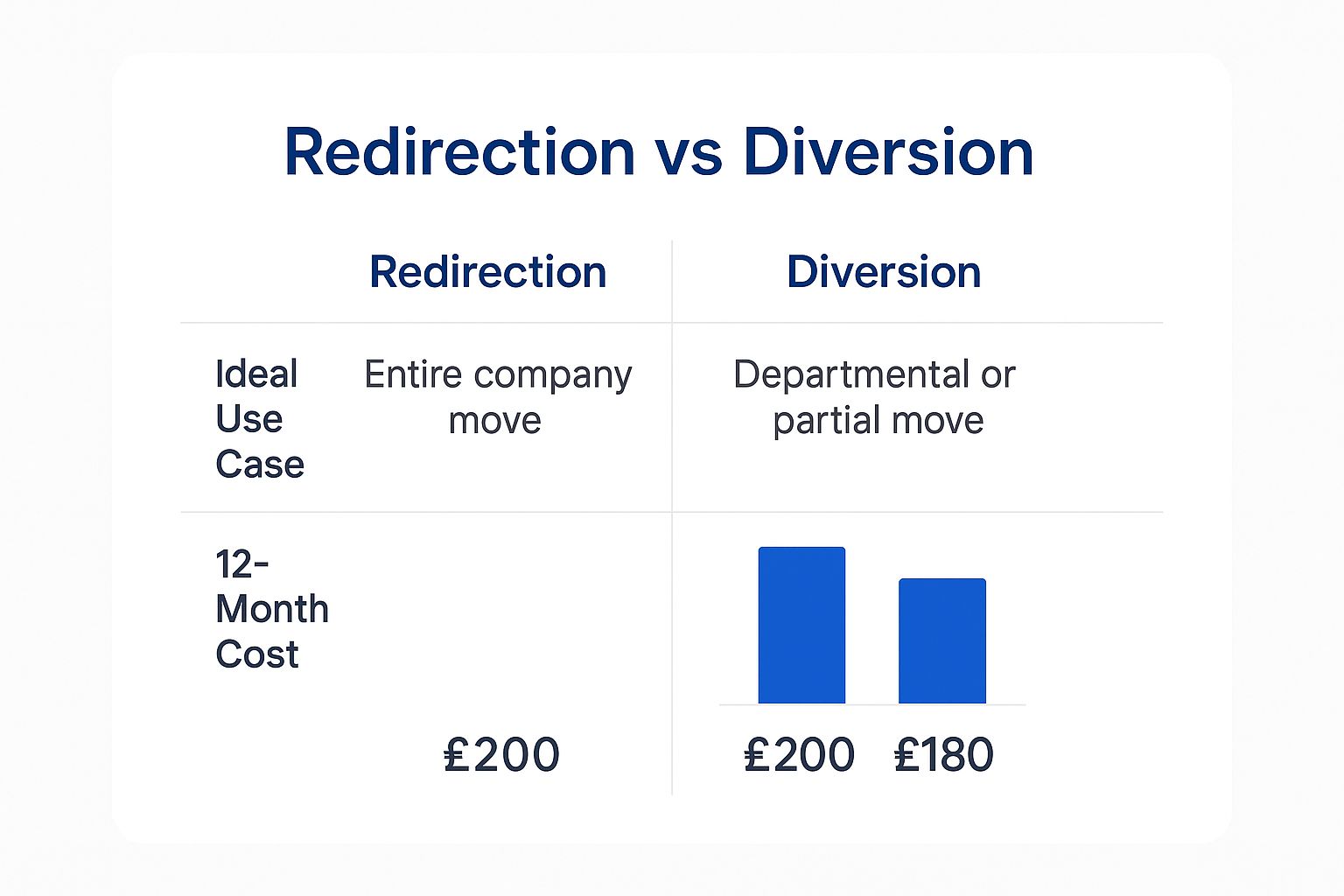UK Business Post Redirection Guide
UK Business Post Redirection Guide – Moving office is a massive project. With so much to juggle, it’s frighteningly easy for one of the most critical details to slip through the cracks: your post. Business post redirection is the official service that catches all the mail sent to your old address and forwards it straight to your new one. Think of it as an essential safety net, making sure no important letters, invoices, or contracts get lost in the shuffle.
Why Business Post Redirection Is Non-Negotiable
Skipping this step isn’t just a minor inconvenience; it’s a huge operational risk. You wouldn’t dream of switching off your digital firewall, right? Business post redirection does the exact same job, but for your physical mail. It shields your business from disruption and stops sensitive information from falling into the wrong hands.
Without it, you’re basically creating a black hole where crucial communications can simply vanish. The consequences can be both severe and immediate.
Protecting Your Financial Stability
The most direct hit you’ll take from missed post is to your bottom line. Invoices from your suppliers, payment reminders you need to send, and even cheques from your clients could all be sitting in an empty building. This quickly spirals into serious problems:
- Late Payment Fees: Imagine a £5,000 invoice from your web developer gets lost. By the time they chase you, you could be facing a £250 late fee and a damaged supplier relationship.
- Delayed Cash Flow: A client’s £10,000 cheque is sent to your old office. That’s £10,000 you can’t use for payroll or reinvestment, putting unnecessary strain on the business.
- Missed Opportunities: A time-sensitive tender document for a major contract arrives at your old address and is returned to the sender. You’ve just lost a chance to grow your business.
It’s easy to underestimate physical mail, but a study by the Direct Marketing Association (DMA) found that 73% of UK consumers actually prefer it for brand communications. This just goes to show it’s still a vital channel for business interactions you can’t afford to miss.
Safeguarding Client Relationships and Reputation
Your company’s reputation is built on being professional and reliable. When mail goes missing, so does your credibility. A misdelivered contract or a lost client letter makes you look disorganised, and that can quickly erode the trust you’ve worked so hard to build.
Then there’s the security risk. Imagine documents with sensitive client data, financial statements, or confidential business plans left at an unattended address. A data breach from unsecured physical mail could land you in hot water with GDPR and do permanent damage to your brand. For businesses that want a more permanent, secure solution, it’s worth exploring the benefits of mailbox rental to maintain a stable, professional front.
At the end of the day, setting up a business post redirection isn’t just another box to tick on your moving checklist. It’s a fundamental move to protect your company’s finances, client relationships, and legal standing during the vulnerable period of an office move. It guarantees continuity and security right when you need it most.
Choosing the Right Mail Forwarding Service
Picking the right type of mail forwarding is a big deal; a simple slip-up here can mean lost post and a lighter wallet. For businesses in the UK, the choice nearly always boils down to two distinct services from providers like Royal Mail: Redirection and Diversion. Getting your head around the difference is the key to making sure your mail actually follows you where you need it to go.
Think of it like this: a Redirection is for a complete, clean-break move. If your entire company is packing up and moving from Address A to Address B, this is the service for you. It’s a blanket instruction to forward all mail from one old address to one new one. Simple.
A Diversion, on the other hand, is the specialist tool for more complex situations where a one-size-fits-all forward just won’t cut it.
When to Choose a Diversion Instead
You’ll need a Diversion service when you’re not the only one at an address or when only a part of your business is on the move. It’s the smart choice if:
- A single department relocates: Practical example: Your marketing team moves to a new creative hub to be closer to clients, while accounts and HR remain at the head office. A Diversion ensures only mail addressed to the marketing team is forwarded.
- You’re in a multi-business building: Practical example: You are a tech startup leaving a co-working space like WeWork. A Diversion specifically picks out mail for “Innovate Ltd” and leaves the post for the other 50 businesses untouched.
- An individual director or employee moves: Practical example: A director retires but still needs their personal business mail sent to their home address. A Diversion can be set up just for “Mr John Smith” at the company address.
This infographic neatly lays out the main use cases and typical costs for each service.

The main takeaway here is that the right service depends entirely on your specific moving circumstances, not just the price tag.
Comparing Business Redirection and Diversion Services
To make it even clearer, let’s break down the core differences between a standard redirection and a more specialised mail diversion. This table should help you quickly identify which service fits your situation.
| Feature | Business Redirection | Business Diversion |
|---|---|---|
| Best For | Entire businesses relocating from one premises to another. | Specific departments, individuals, or businesses in shared spaces. |
| Mail Handling | All mail sent to the old address is forwarded. | Only mail for the specified business name/person is sorted and sent on. |
| Complexity | Simple setup for a single, straightforward move. | More detailed setup, requiring specific names to be identified. |
| Common Scenario | A company moves its entire office to a new building. | A law firm leaves a building with multiple other tenants. |
| Cost | Generally the lower-cost option. | Typically higher due to name-specific sorting and administration. |
Ultimately, a Redirection is a blunt instrument that moves everything, while a Diversion is a precision tool designed for more complicated moves.
Understanding the Costs and Options
In the UK, business post redirection is always a paid-for service; there are no free rides for commercial addresses. The final cost will depend on the provider and how long you need it for—usually three, six, or twelve months. When you’re doing your sums, it’s vital to remember that if you’re in a shared building or only moving part of the business, a standard redirection is the wrong tool for the job. You have to opt for a business mail diversion service, which comes with its own price list.
Choosing the right duration is just as important as choosing the right service. A shorter term might look cheaper, but a 12-month redirection is what we’d strongly recommend. It’s the only way to be sure you’ll catch those annual renewals, infrequent client letters, and official notices you might otherwise miss.
For businesses that need something more permanent and flexible than a temporary forward, a virtual mailing address offers a stable, professional base for all your correspondence. Find out more about how a virtual mailing address can support your business no matter where you operate from. It’s a solution that provides long-term stability that goes far beyond a simple move.
Your Step-By-Step Redirection Setup Guide

Let’s be honest, sorting out your business post redirection can feel like just another tedious task on a never-ending moving checklist. But with a bit of prep, you can turn this potential headache into a smooth, straightforward process. This guide will walk you through exactly what you need to do, step by step.
Before you even think about filling in a form, the best thing you can do is get your documents in order. Think of it like organising your ingredients before you start cooking – it just makes everything quicker and less stressful. You’ll need to prove who you are and your connection to the business.
Your Essential Preparation Checklist
Getting everything together beforehand means you won’t have to scramble for paperwork mid-application. Whether you’re doing it online or at the Post Office, make sure you have these bits and pieces ready to go:
- Proof of Business Address: A recent utility bill, bank statement, or a signed lease for the old address will do the trick.
- Proof of Personal Identity: You’ll need a valid passport or a UK photocard driving licence for the person applying.
- Link to the Business: This is just a document that proves you have the authority to set this up. A letter on company letterhead, signed by a director, confirming you can act on the business’s behalf is perfect.
Actionable insight: Before you apply, create a list of all your company’s trading names. For example, if your legal name is “ABC Innovations Ltd” but you also trade as “ABC Creative” and “Innovate Solutions”, you must include all three names on the application to ensure every piece of mail is caught.
Once you’ve gathered these documents, you’re all set to get the application started.
The Application Process Explained
My biggest piece of advice? Don’t leave it to the last minute. You should aim to submit your application at least three weeks before your moving date. This gives the postal service plenty of time to get everything processed so the service is live the day you need it.
You’ve got two main ways to set up your business post redirection:
- Online Application: This is usually the fastest option. You’ll be taken through a simple digital form where you pop in your old and new address details, upload scanned copies of your documents, and pay the fee.
- Post Office Application: If you’d rather do things in person, you can fill out a form at a Post Office branch. Just remember to bring your original documents with you so the staff can verify them.
Whichever way you go, the golden rule is to double-check everything. A tiny typo in an address or a name can cause massive delays, which completely defeats the purpose of setting up the redirection in the first place. A few minutes of careful checking now can save you a world of hassle later.
Meeting Your Legal and Compliance Duties
While sorting out your business post redirection is a smart practical move, it’s really just one piece of a much larger puzzle. When you change your business address, you trigger a whole host of serious legal and compliance duties you absolutely cannot afford to ignore.
This isn’t just about making sure letters find their way to your new office. It’s about keeping your company in good standing with the UK authorities, and the stakes are high.
For any limited company, the number one priority is to formally update your registered office address. This is your official address on record with Companies House and HMRC, used for all statutory mail. Getting this wrong can lead to some pretty severe consequences, from fines right through to your company being struck off the official register.
If you’re a bit fuzzy on the details, we’ve got a detailed guide that explains everything you need to know about what is a registered office.
Handling Sensitive Mail and GDPR
Your compliance duties don’t stop there; they extend deep into data protection. Think about the kind of mail your business receives. It’s often packed with sensitive personal and commercial information, like employee NI numbers or confidential client contracts.
Under GDPR, you have a legal duty to protect this data. A physical move is a high-risk time for potential data breaches, and just hoping for the best isn’t a viable strategy.
If a letter containing personal data goes astray, that’s a data breach. It could land you with a hefty fine from the Information Commissioner’s Office (ICO) and do lasting damage to your reputation. A secure mail redirection service acts as a crucial safeguard, making sure sensitive post is rerouted securely and doesn’t end up in the wrong hands.
Don’t underestimate the power of physical mail. A recent study found that 73% of UK consumers actually prefer getting brand communications via direct mail. It generates an impressive 4.9% response rate—miles ahead of email. This just goes to show the volume and importance of the mail you need to protect during a move. You can find more insights on the effectiveness of direct mail at uk.paragon.world.
Your Essential Notification Checklist
Beyond the official government bodies, there’s a long list of people and organisations you need to inform about your new address. Forgetting just one can cause serious disruption to your operations.
Use this checklist to make sure you’ve covered all the bases:
- Financial Institutions: Tell your bank, any loan providers, and your payment services like Stripe or PayPal.
- Insurance Providers: Actionable insight: Call your insurer to update your policies. A new location can affect your premiums for contents or liability insurance, and failing to notify them could invalidate your cover.
- Clients and Customers: Let all your clients know proactively. The last thing you want is invoices and payments going to the wrong address.
- Suppliers and Vendors: Inform your suppliers where to send their invoices and deliveries to avoid payment delays and operational hiccups.
- Professional Services: Don’t forget to notify your accountant, solicitor, and any other professional advisors you rely on.
By methodically working through these legal and admin tasks alongside setting up your business post redirection, you can ensure your move is not just smooth, but fully compliant too.
Common Redirection Mistakes and How to Avoid Them

It’s surprisingly easy to make a small slip-up when setting up your mail redirection, only for it to cause major headaches down the line. We’ve seen it happen time and again. Learning from the most common pitfalls is the best way to ensure a smooth, stress-free transition.
The most frequent mistake? Leaving it all to the last minute. Trying to set it up just a few days before you move is a recipe for disaster, creating a risky gap where crucial mail can get lost. Always apply at least three weeks in advance to make sure the service is live from the moment you get the keys.
Another classic error is forgetting to list every single trading name you use. If a letter or invoice arrives addressed to a name that isn’t on your application, it won’t get redirected. More often than not, it’ll be sent straight back to the sender, which can disrupt supplier relationships and delay vital payments.
Misunderstanding Service Limitations
One of the biggest sources of confusion is the assumption that a business redirection service will catch everything sent to your old address. This is a critical, and potentially costly, misunderstanding.
The most significant limitation is that postal redirection services typically only handle mail and parcels delivered by the national postal service, like Royal Mail. They do not cover items sent via private couriers.
This means you absolutely have to take separate, proactive steps to deal with deliveries from other carriers.
- Contact Your Suppliers: Get on the phone or send an email to all your key suppliers, giving them your new delivery address. Actionable insight: Create a spreadsheet of your top 20 suppliers and track when you notified them and received confirmation.
- Update Courier Accounts: If you have business accounts with services like DPD, Evri, or FedEx, log in and change your default delivery address there. It only takes a minute.
- Inform Your Team: Make sure everyone in your company who places orders knows about the new address and uses it from day one.
Failing to sort out your courier deliveries separately is one of the fastest ways to lose valuable stock and throw your operations into chaos.
On top of this, the UK postal system itself is changing. By early 2025, reforms will mean non-priority business mail shifts to a three-day delivery target, which could add delays to your redirected post. It’s worth reading up on how postal reforms could impact your small business at obrienmedia.co.uk and factoring these potential delays into your planning.
Got Questions About Business Mail Redirection? We’ve Got Answers.
Here are some quick, clear answers to the questions we hear most often from business owners about post redirection.
How Long Should I Keep My Business Post Redirection Active?
We always recommend keeping it going for a minimum of 12 months. It might seem like a long time, but this window is crucial for catching those annual renewal letters, infrequent official notices, and stray invoices from suppliers you might have forgotten about.
A good tip is to do a quick ‘mail audit’ around the nine-month mark. This gives you a clear picture of what’s still arriving at your old address, so you can decide whether to extend the service or let it end.
Will My Redirection Cover Parcels from All Couriers?
No, and this is a really important point to remember. A business post redirection service from Royal Mail will only forward items that come through its own network. It won’t touch parcels sent with private couriers like DPD or Evri.
Practical example: A critical component ordered for a client project is shipped via DPD to your old address. Without a redirection, the package will be returned to the supplier, causing project delays and potentially costing you a client. You must update your address directly with that supplier.
What Happens If I Forget to List One of My Trading Names?
Forgetting a trading name on your application can cause real disruption. Any post addressed to that name will likely be sent straight back to the sender, marked as ‘addressee gone away’.
If this happens, you’ll need to contact your redirection provider right away to get your active service amended. Just be aware that they might charge a small admin fee to update the details.
For a complete suite of services that goes beyond simple mail forwarding, including virtual offices and company compliance, you can count on Acorn Business Solutions to support your company’s journey. Find out how we can help your business grow.
Checkout Acorns Professional Registered Office Service
Blog Categories
- Startups
- Sales & Marketing
- Leadership
- Finance & Accounting
- Technology & Innovation
- Customer Experience
- Sustainability & Ethics
- Personal Development
- Success Stories
- Legal & Compliance
- Hiring & HR
- Small Business Tips
- E-Commerce
- Networking
- Acorn Insights
- Industry News
Related Topics
How Do You Redirect Your Mail in the UK?
When you’re moving house or relocating your business, your post is a critical piece of the puzzle. You’ve got two main routes to make sure it follows you: the official Royal Mail Redirection service or a more flexible private mail forwarding service. Which one is right for you? It really boils down to what you
How Do You Redirect Your Mail in the UK?
Moving home? Learn how do you redirect your mail with Royal Mail or private services. A practical guide to costs, setup,
Top accounting courses for small business in the UK (2025)
Discover accounting courses for small business in the UK. Compare top options, pricing, and formats
UK Business Bank Accounts With No credit Checks
Discover UK business bank accounts with no credit checks. This guide explains your options and eligibility
Managing cash flow for small business: Quick tips
Discover managing cash flow for small business with practical steps to forecast, optimize liquidity,
Your Guide to the company unique tax reference number
Discover what the company unique tax reference number is, why you need it, and how to locate yours quickly.





